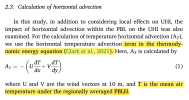Hi everyone.
Following the methodology provided by a paper, I am trying to calculate the temperature horizontal advection. According to this paper, to finish this, the mean air temperature under the regionally averaged PBLH should be calculated.
The regionally averaged PBLH can be easily calculated, but how should I obtain air temperature under this height (in meters)?
Is that possible to use interplevel in wrf-python?

Following the methodology provided by a paper, I am trying to calculate the temperature horizontal advection. According to this paper, to finish this, the mean air temperature under the regionally averaged PBLH should be calculated.
The regionally averaged PBLH can be easily calculated, but how should I obtain air temperature under this height (in meters)?
Is that possible to use interplevel in wrf-python?

